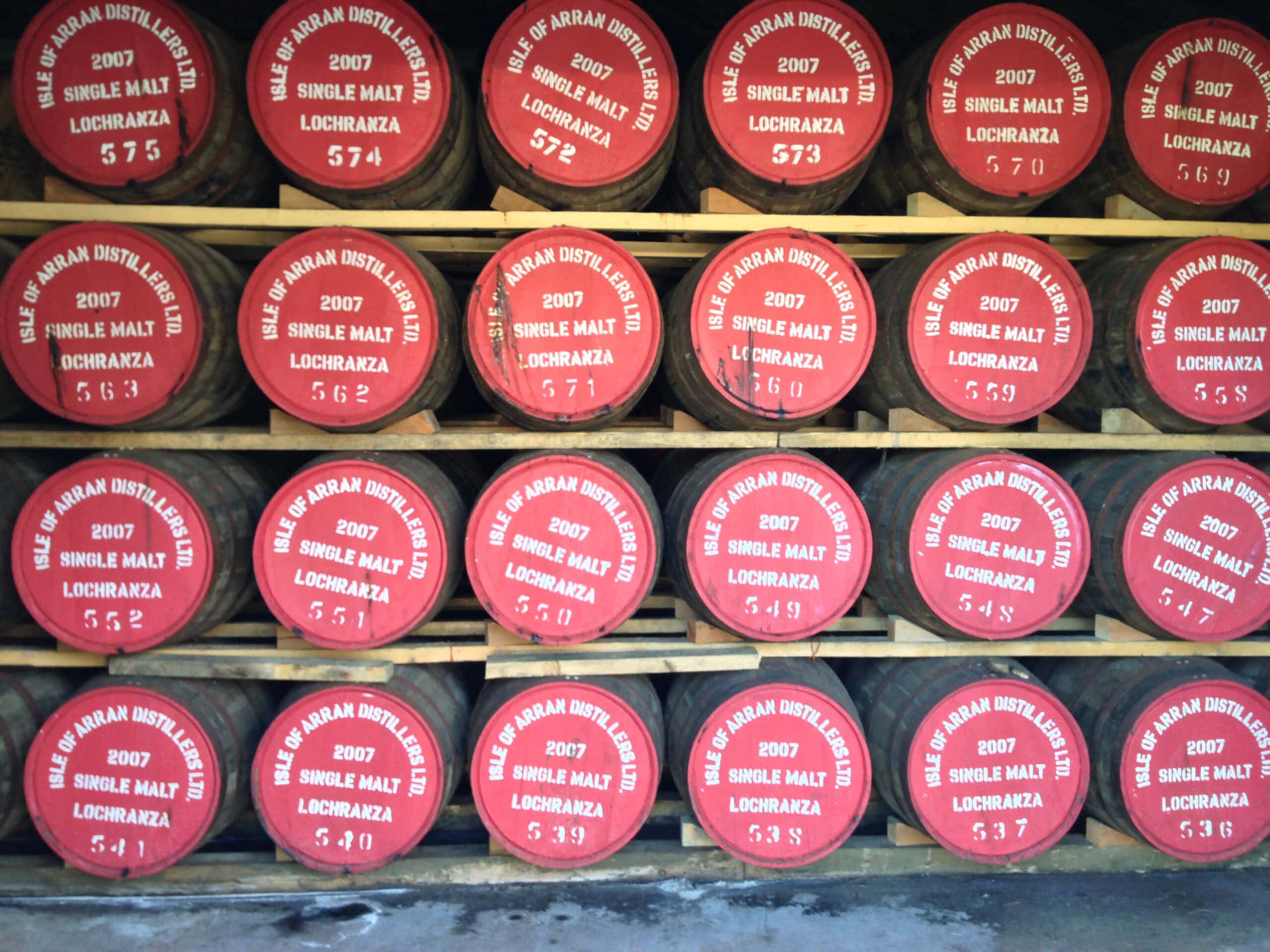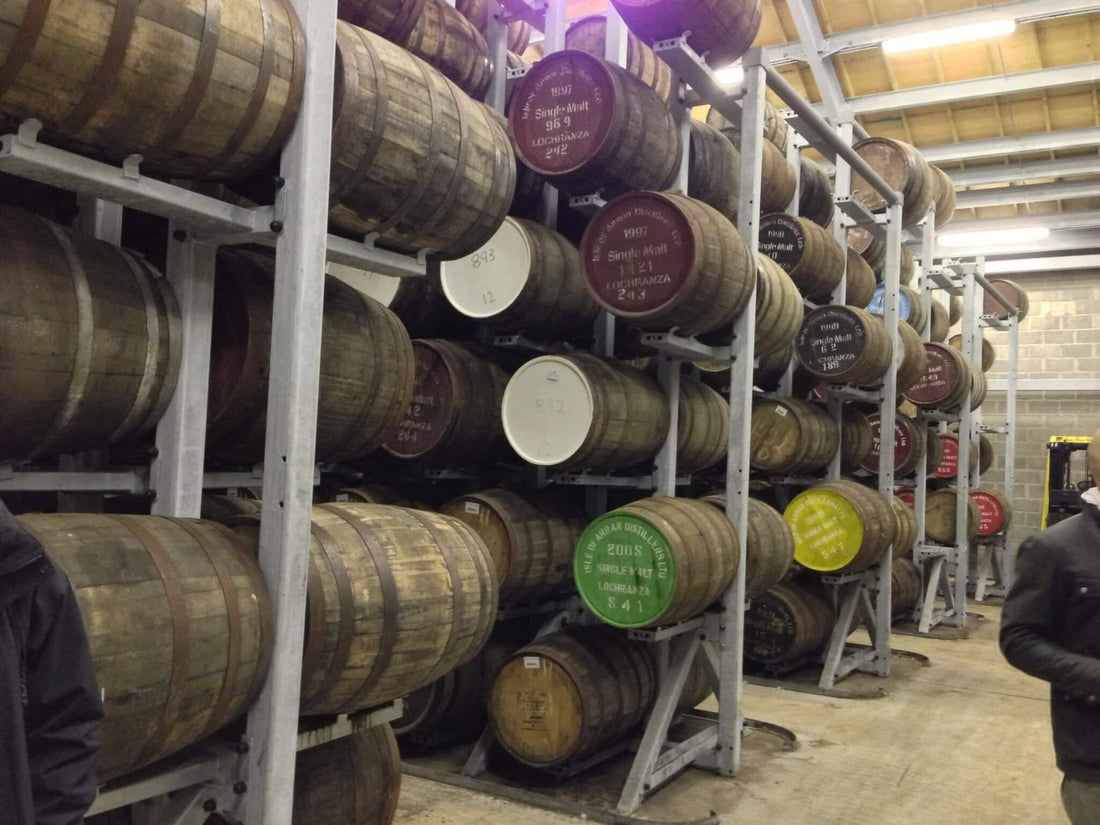The ad ran something like this.
“Invest in a new distillery in the Isle of Arran. Your £450 payment will result in 12 cases of blended whisky and a holder of a Founders Bond. You will also receive a personal tour of the distillery.” Now this seemed a good investment, as £450 converted to around $5 a bottle at that time.
Invest in a distillery in Arran? Arran, the fabled island that used to have over 50 legal and illegal distilleries in it? Rumors abounded about the quality of the whisky produced there, but as the last distillery closed in the 1800s, no one really knew for sure. As a whisky lover, I was hooked. I promptly sent in my money.
The Isle of Arran Distillery is situated about half a mile from the Kilbranan Sound, which faces the Mull of Kintyre, whose main town, Cambelltown, is the home of Springbank Distillery (really good whisky). To get to Arran, I took the ferry from Ardrossan, which is an hour west of Glasgow. As you glide (on a calm day) over the Firth of Clyde to Brodick on the east coast of Arran, you are exposed to some of the most spectacular views in Scotland. To the north is the island of Bute and to the south lies Ailsa Craig, an uninhabited island that is famous for its blue granite, used to make curling stones. If you look west to the island, you can clearly see “The Sleeping Warrior” – a mountain range that in relief that looks similar to a resting human body. The drive to the village of Lochranza is short and takes you through some picturesque Scottish villages.
The distillery is most impressive. It is a cluster of white buildings with pagodas on top. They are really ventilators designed to stop spontaneous combustion of the grain by allowing air to pass through it. As grain is no longer stored in large piles, I wonder if the pagodas are just used as a decoration, or of they are essential to the aging process. Nevertheless, they are pretty and add enigma.

Lochranza Distillery. Courtesy of Wikimedia Commons/Paul Birrell/Lochranza Distillery, Isle of Arran.
At the time of my visit the distillery had not yet produced their first bottling so I couldn’t sample my investment. And yet, the tour was very interesting. It was the first time I had ever visited a new distillery and the place positively gleamed. The tour guide made a big fuss about the water on the island. In the lore, the water in Arran is the reason their whiskies tasted so good. I did taste it and found it clear and sweet, but unremarkable for Scottish water.
This was a long-term investment. It took them a couple of years to build the place, and after the distillation started, it still took many more years to produce the spirit.
From time to time I would receive updates on production.
“Spirit aging well in casks.”
“Unique flavor profiles in Arran Malt.”
“First tastings most promising.”

Courtesy of Wikimedia Commons/sebastian.b.
Many years later, my whisky was ready for collection. I could pick up the 12 cases of blended or, as a substitution, five cases of single malt. I chose the latter. Now came the arduous task of bringing it into the US. My first idea was to just ship them but as a frequent flyer, I knew just how sticky US customs can be if you bring in more than one or two bottles.
So what to do? I contacted a friend in Edinburgh who worked for the Scotch Whisky Distillers Association. He suggested I call his friend in Washington who had something to do with alcohol. His friend in Washington turned out to be very knowledgeable, and after the usual pleasantries he told me that without a liquor license it is illegal to bring in that quantity of whisky. Even if I offered to pay the duty, it was still illegal, as I did not have the license, and customs would suspect that I wanted to resell the bottles. After that we talked about our mutual friend in Scotland, about our favorite whiskies and how the laws were really hangovers from prohibition muddled by individual state laws.
When we had finished, I asked him what he did in Washington. “Me? I’m the head of the ATF (Bureau of Alcohol, Tobacco and Firearms). President Bill Clinton appointed me.”
Eventfully an importer of Scotch agreed to bring in the shipment and deliver the five cases to me. By the time it arrived, each bottle cost me over $60. I was eager to try it.
I opened the first bottle and it had a floral smell with an underlying chemical note. Not a good start. I tasted it and swirled it around my mouth. The chemical odor became more pronounced. It was foul tasting.
I opened a second bottle but it was the same. I feared that the whisky was too young and needed more time to develop. Unfortunately, once it is in the bottle, it doesn’t change. I was really disappointed.
I ended up giving them away at a trade show in Las Vegas. Some of my friends told me later that they couldn’t drink it. The distillery now has bottlings of 10, 12 and 18 year-old malts and generally gets good ratings. I on the other hand, have never tasted another dram of their spirit.
******
This story was written a few years ago.
Last year on a trip to Israel via Heathrow Airport in London, I stopped at World of Whiskies, a store with a large selection of malt whiskies. They generously allow customers to taste them. They had an 18 year old Arran single malt and I felt duty-bound to taste it.
It was not good. it had an almost burnt taste with a fruity odor. The finish was too long (in other words, it took far too long for the taste to disappear).
I doubt I will invest in another distillery.
Header image courtesy of Wikimedia Commons/sebastian.b.



